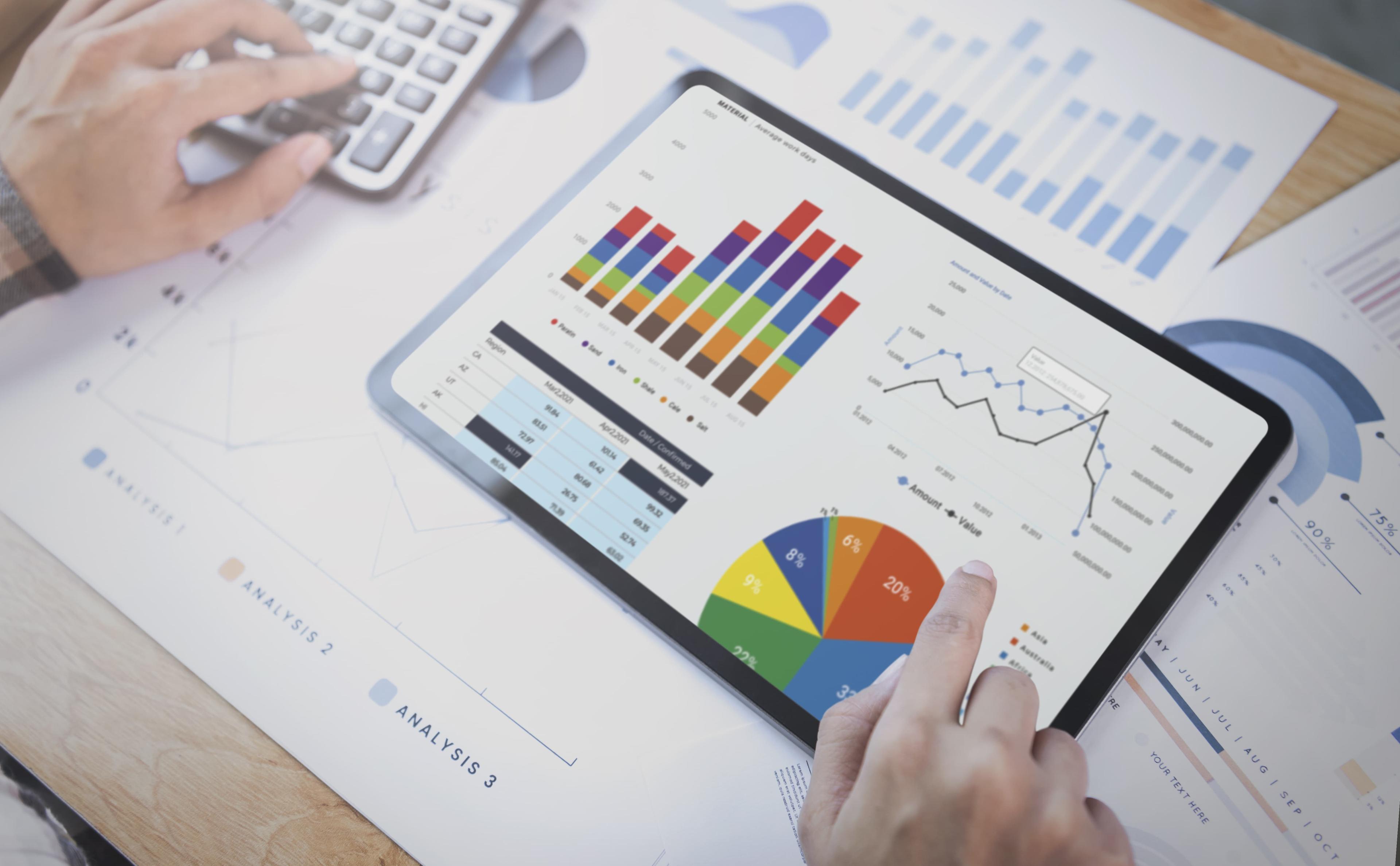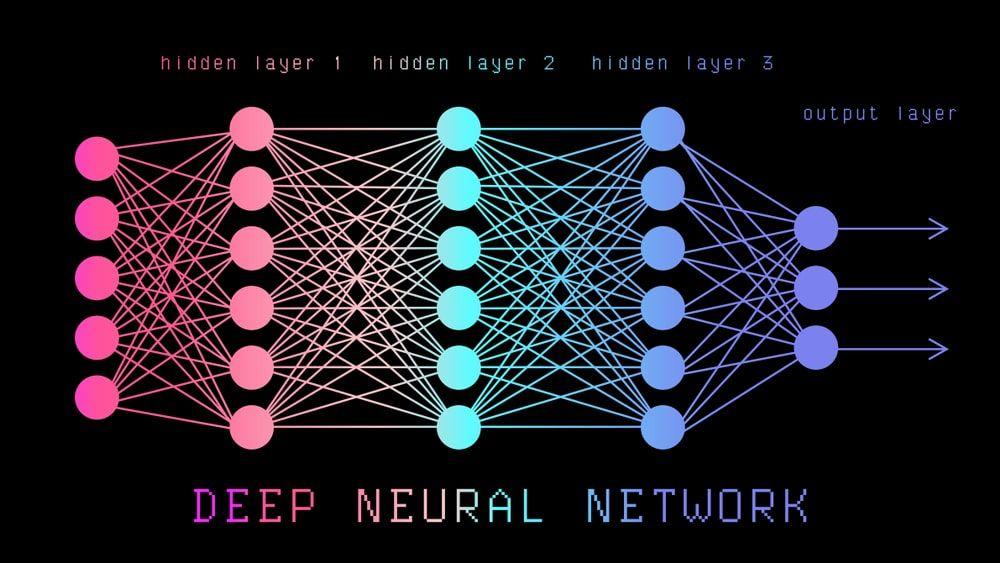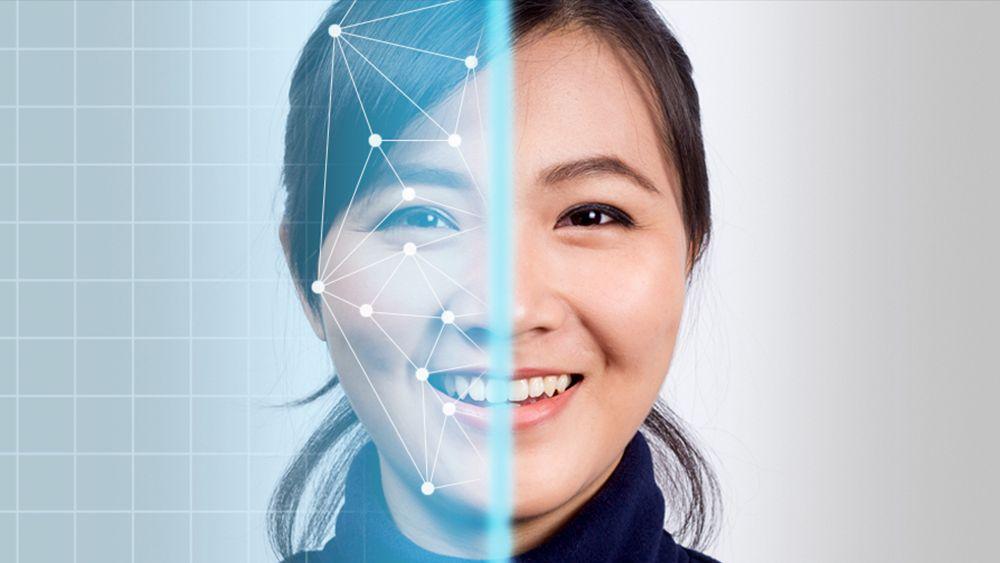What is AI Visual Inspection for Defect Detection? : A Deep Dive
Artificial intelligence for businesses remains a key differentiator, with numerous applications in almost every domain. From self-driving cars to Siri and Alexa, AI is the key enabler for next-generation services transforming the way we live.
AI can enable systems to make intelligent decisions based on past data, from deciding which products customers might like best to identifying potential medical problems before they escalate into emergencies. Among this wide range of AI applications around the globe, automated visual inspection is highly appreciated.
Automated visual inspection techniques can help save your business time, effort, and money. Read on to discover how automatic visual evaluation and a deep learning approach can save significant time and effort.
How AI-Based Visual Inspection Enhances Defect Detection?
Visual inspection is one of the most commonly used approaches in the production process. It entails visually inspecting the components of an assembly line to detect and repair problems.
However, AI-based visual inspection is frequently described as some form of optical inspection technique based on deep learning and computer vision. It is the process of monitoring and inspecting a manufacturing or service operation to ensure that products meet predetermined specifications.
A computer is used to capture, record, and store images as well as objects. Thus, it saves time and also increases efficiency. For example, if an inspector inspects an assembly line, it may take him/her a couple of hours to finish the inspection process, whereas AI-powered software will scan the assembly line within a few minutes.
Since the advent of industry 4.0 tools, manufacturers can leverage cloud computing capabilities with AI. Here, a camera performs a thorough equipment scan and shares the image on the cloud. A machine learning algorithm analyzes the image for defect detection and identifies any potential defects and nonconformities.
A huge amount of data and images are fed into the system to help reveal even the slightest abnormalities with product quality to enhance defect detection accuracy, eliminating the possibility of human error. The algorithms also contribute largely to reducing the average time taken for thorough inspection compared to human inspection.
What is Deep Learning in a Visual Inspection?
Deep learning technology is becoming more and more popular for use in various industries. Its primary benefit is allowing machines to learn by example rather than explicitly program. Doing this makes it a powerful tool for tasks that are difficult to automate, such as visual inspection.
The basic principle of deep learning is to teach a machine to recognize specific patterns by providing a neural network with labeled examples. Once the device has learned those patterns, it can apply them to new data to identify the defects.
Integrating deep learning algorithms with automated visual inspection technology allows discriminating components, abnormalities, and characters, simulating a human visual examination while running a computerized system.
Application of Automated Visual Inspection
Automated visual inspection is widely used in manufacturing to assess the quality or defects. It can help prevent potential negative impacts, such as those that may occur when an organization meets specific compliance requirements. However, you can also use it in non-production environments to determine whether the features indicative of a “target” are present or not.
There are many industry domains where automated visual assessment is required as the high priority activity, due to the potential errors that may arise via manual inspection, such as loss of expensive equipment, chances of injury, rework, or loss of a customer.
The high-priority business domains where automated visual inspection is prioritized include airport screening, the food industry, pharmaceutical, and nuclear weapons manufacturing.
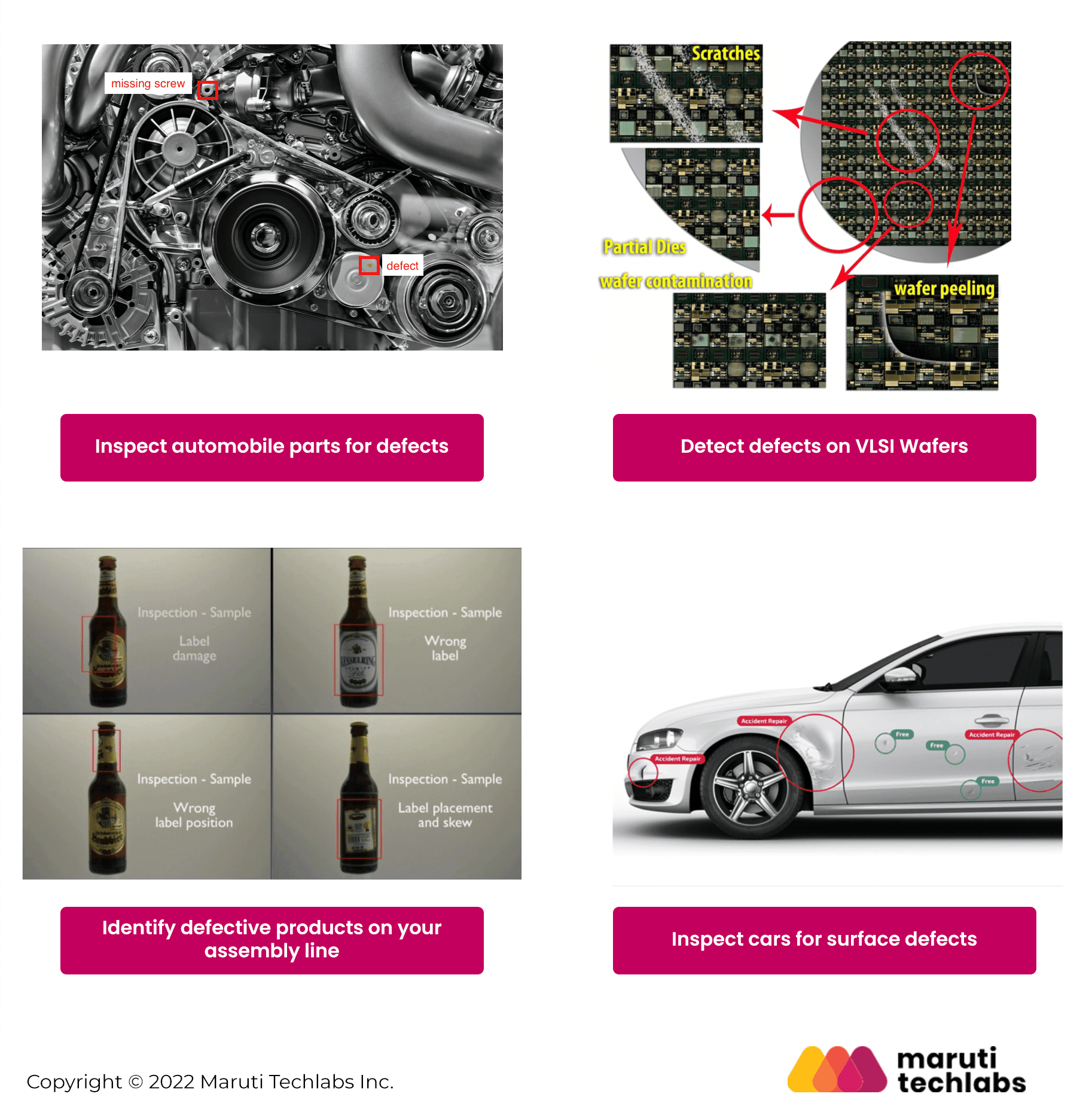
Limitations of Manual Testing
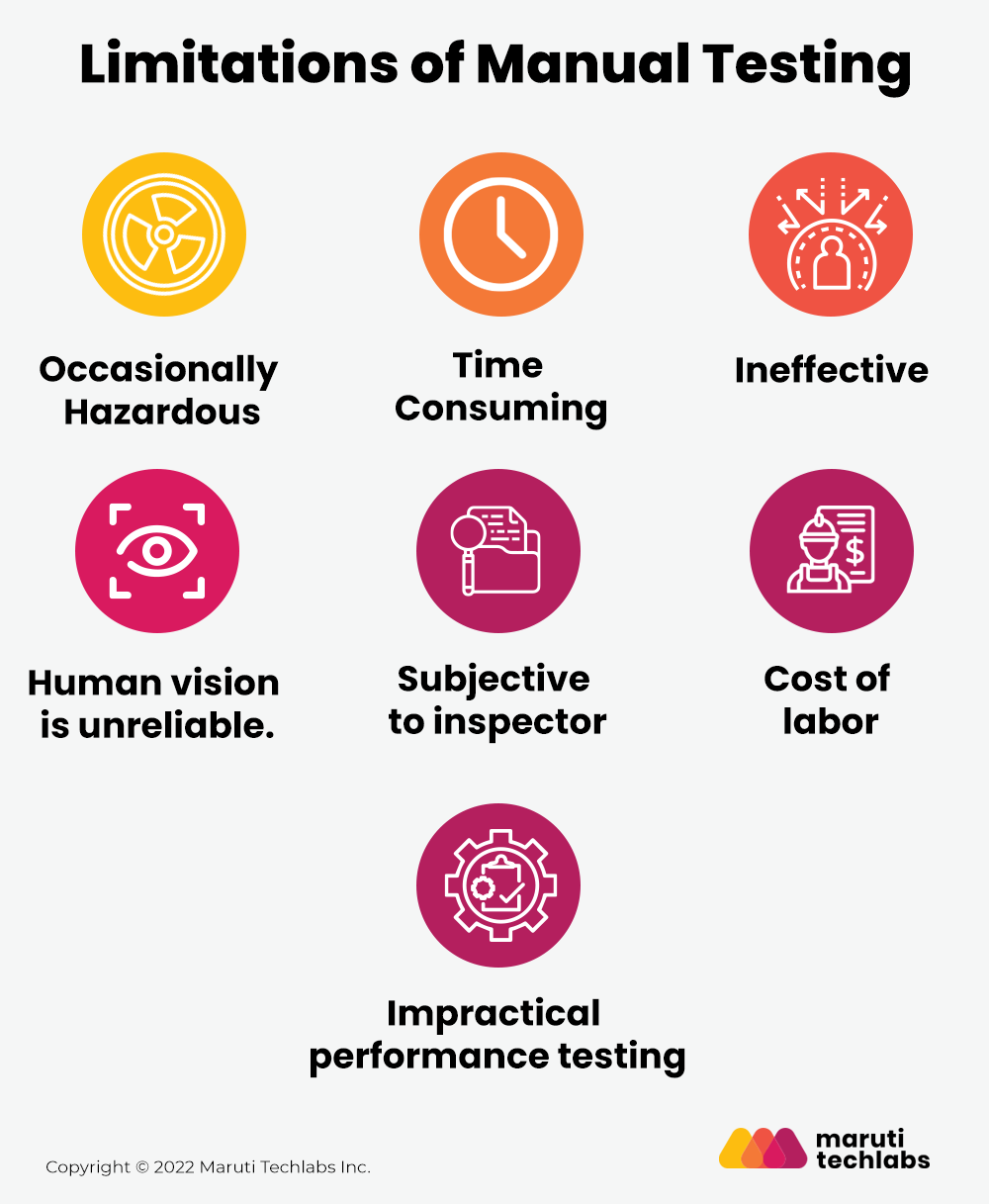
Many companies rely on manual testing as their only quality control measure, but this approach has limitations. Let’s explore some of these limitations:
1. Occasionally Hazardous
Not every time the defect detection entity is safe to inspect. When assessing elements like baggage screening or aircraft maintenance, there are multiple risks involved to inspect such entities under normal conditions.
2. Time Consuming
In property and casualty businesses, studying and assessing the damage to a building or automobile usually takes time. Hence, the inspection and claim settlement process is quite lengthy. Because most of these activities or scenarios are done repeatedly, manual testing takes considerable time.
In such cases, computer vision can significantly speed up the process, minimize mistakes and prevent fraud. Moreover, you can use satellite imagery, drones, and big data to do these computer-assisted inspections.
A typical machine learning application analyzes behavioral data such as facial expressions or voice tone during underwriting. For example, in the case of health insurance, it is projected that behavior monitoring will provide over 40% of risk information.
Additional Read – 9 Real-World Problems Solved by Machine Learning
However, behavioral data is also essential in non-life insurance. For instance, identifying particular trends in how a person runs a machine may suggest process problems resulting in insurance claims.
3. Ineffective
Manual inspection is prone to making two forms of mistake, either failing to detect the error or identifying the defect which doesn’t exist. This ineffective visual detection can lead to ineffective estimations and a waste of employee efforts.
4. Human Vision is Unreliable.
Optical illusions are an example of how untrustworthy the human eye can be. Moreover, when comparing two similar objects with small dimensions, there are chances that the human eye will fail to recognize the slight difference in measurements. It isn’t to say that manual examination is useless; it indicates that relying solely on it isn’t a good idea.
5. Subjective to Inspector
The manual testing procedure is inconsistent since each individual’s testing methods, and tactics vary. Because this yields ranged results on the same test, variance in the test method is unavoidable.
6. Impractical Performance Testing
Performance testing of any client-server application necessitates the use of humans and computers. Client programs must be installed on several PCs and tested by a single person to determine the overall performance of the software, which is a time-consuming and challenging job.
7. Cost of Labor
As individuals on a large scale cannot handle quality inspection, companies tend to hire multiple skilled trainers, and hence, the manual examination remains a costly endeavor. According to Glassdoor, manual inspection operators may earn anywhere between $50,000 and $60,000 per year.
Advantages of Automated Visual Inspection

Below are some common reasons you should choose automated visual inspection for quality testing.
1. Better Perception
Machine vision has a high optical resolution, depending on the technology and equipment used for automated visual inspection. Compared to human sight, machines have a broad spectrum of observation to handle ultraviolet, infrared, and x-ray regions.
2. Faster
Observations and conclusions are made almost instantaneously, with the speed of a computer’s processing power as measured in FLOPs (floating-point operations per second). Also, they result in exact calculations.
For instance, insurance underwriters spend a considerable amount of time manually moving data from one software system to another, leaving little time for higher-value tasks like reasoning from data, selling, or interacting with brokers. In such cases, AI-enabled optical character recognition can save significant amounts of time and manual labor.
3. Reliable
Machines are impartial and programmable to perform the desired task. They are entirely reliable in following the given instructions without any counter questions.
4. Accurate
Unlike manual inspection, where there is a limitation to human eyesight, automated visual inspection systems can measure absolute dimensions with a high degree of precision.
5. Independent of Environment
It is easy to deploy an automated system even in dangerous environments where human involvement would be risky.
How to Integrate AI Visual Inspection System
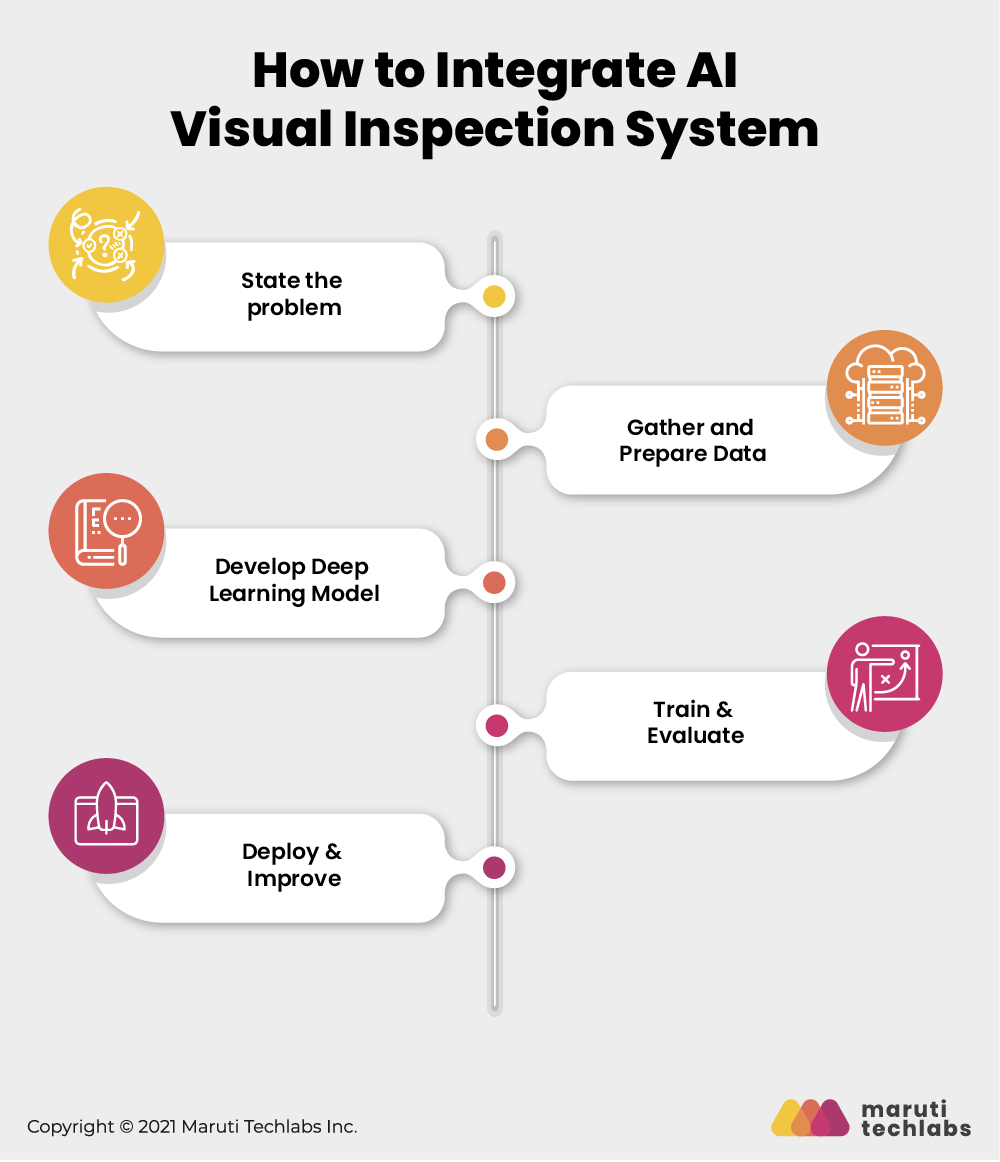
Below are the five steps to follow while integrating an automated visual inspection system:
1. State the Problem
It is essential to understand that the goal of the inspection is not to find all possible defects but to determine what kind of defects the system should detect. These are the defects that affect quality, safety, and reliability so that the customer can identify and care about them. To help you with the same, here are the essential steps to follow while identifying the actual problem statement for integrating automated inspection in manufacturing:
- Identify your system environment.
- Define whether the detection is to be real-time or deferred.
- Identify system notification when the defect is detected.
- Check whether you need to develop the new system from scratch or your default system enables the defect detection functionality.
2. Gather and Prepare Data
As an engineer in the data science field, you must prepare and gather the required data sets before deep learning can begin. For manufacturing industries, it’s important to digitize the product supply chain through IoT analytics. For instance, if we are talking about video records, the data preparation can include extracting frames from videos and creating bounding boxes on relevant objects on these frames.
There are many ways to collect the dataset; however, below are some of the standard methods:
- Utilizing video records provided by a client
- Engaging in open-source video recording applicable for a defined purpose
- Collecting data from scratch according to deep learning model requirements
After obtaining the data, we make sure it is orderly and ready to be modeled. Any anomalies explicitly related to this are checked for before proceeding.
3. Develop Deep Learning Model
In this stage, you identify the perfect deep learning model depending on the complexity of your system, budget limitations, and time constraints. Below are some of the common approaches:
- Model Development Services [Such as Google Cloud ML Engine, Amazon ML]
This approach is based on feature engineering. You are provided with the set of heuristic rules that experts in the field specifically derived to detect objects in images. This type of model is beneficial when the requirements of defect detection features are in line with the templates provided by the service. Doing this can save time and budget as there is no need to develop the model from scratch.
- Using Pre-trained Models
A pre-trained model is a deep learning model that has previously been constructed and performs tasks similar to those you want to complete. Pre-trained models may not always succeed on all of our tasks, but they offer significant time and cost savings. Using models previously trained to solve large datasets allows us to customize them for our needs.
- Deep Learning Model Development from Scratch
When developing the custom deep learning model from scratch, a data scientist should consider using many computer vision algorithms, for example, image segmentation, object detection, etc. This method is ideal for complex, secure inspecting systems. The approach may be time and effort-intensive, but the results are worth it.
For instance, consider an automated visual inspection system for assessing the automotive parts that detect scratches on the metal surface. After training the system, it can accurately detect all kinds of dents and scratches. In such cases, you don’t need to develop a completely different model and instead collect the images depicting defective, unacceptable parts.
4. Train & Evaluate
After developing the visual inspection model for your system, now it’s time to train it. Here, the data scientist has to test and evaluate the performance of your system and its result accuracy. Test dataset may be anything that can support the automated visual inspection system; it may be a set of video records that we are processing.
5. Deploy & Improve
Once you evaluate your model, it’s time to deploy and inspect it daily. Instead of directly applying your model on a large scale, you can test it on some of your products and identify its accuracy. If it satisfies the requirements you are looking for, you are good to integrate it with your entire system. Also, it is recommended to regulate your model quickly using the new dataset and trends available in the market.
Equipment Needed for Automated Visual Inspection
Automated visual inspection does not require much physical equipment to perform its task. However, some of the requirements needed to start automated visual inspection are divided into hardware and software as below:
Hardware
Devices needed to implement an automated visual inspection system may vary depending on the industry and automation. Some of them are:
a] Camera: Real-time video streaming is the essential camera choice. IP and CCTV are two such examples.
b] CPU/GPU: When real-time results are necessary, a GPU would be better than a CPU because GPUs have a faster processing speed for image-based deep learning models.
c] Drones: Building interiors, gas pipelines, tanker visual inspection, and rocket/shuttle inspection are examples of automated assessment of hard-to-reach regions that might benefit from drones.
Moreover, depending on the industry use and your system, physical equipment can be divided into three categories as below:
- Feeding System: This allows the optical system to collect frames of individual items by spreading them out equally and moving them steadily.
- The Optical System: This consists of a sensor and a specially tuned illumination source. The optical system captures images of examined goods, which are then processed and analyzed by the software.
- Separation System: Removes faulty goods and grades and divides things into different quality groups.
Software
The software layer is the core component for automated visual inspection as it helps to inspect the product or object with interest to identify the presence of a defect. The software part of the computerized system requires advanced image processing algorithms that can adjust quality, locate exciting points, and identify the results based on features found in these areas.
The software structure that uses automated visual inspection is based on web-based data transfer and neural network processing. The key parameter here is data storage which can be done in the following ways:
- Local Server
- Cloud Streaming Server
- Serverless Architecture
Here, the choice of data storage solution often depends on the deep learning model functionality. For instance, if the visual inspection system uses a large dataset, the ideal choice for this system would be to choose a cloud streaming server.
Deep learning models have proven vital software components because of their enormous effectiveness in tackling inspection difficulties. A deep-learning algorithm, for example, may be trained on hundreds of photos of flowers and eventually learns to recognize any significant differences from the “typical” look of a flower.
Automated Visual Inspection: Key Takeaways
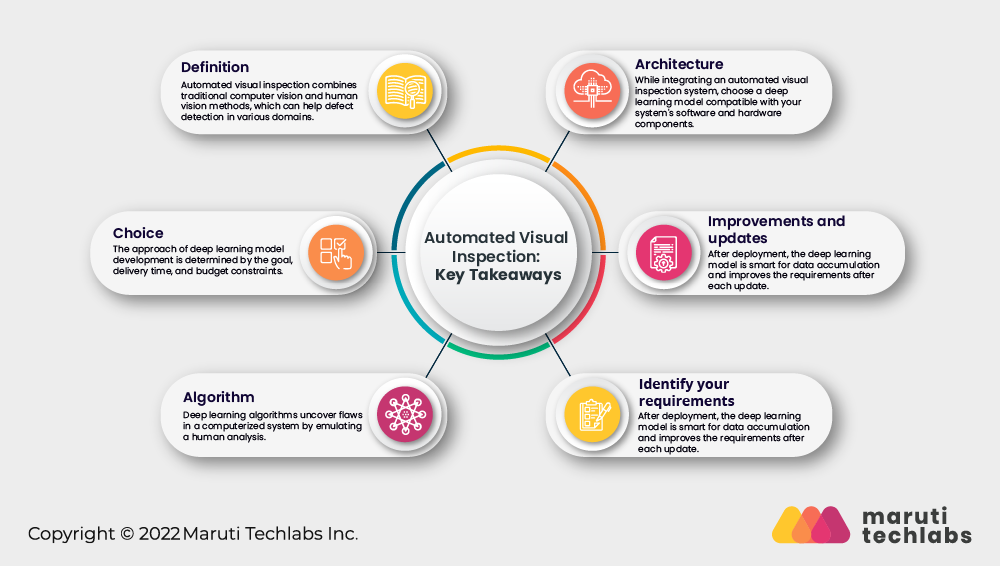
- Definition
Automated visual inspection combines traditional computer vision and human vision methods, which can help defect detection in various domains.
- Choice
The goal, delivery time, and budget constraints determine the deep learning model development approach.
- Algorithm
Deep learning algorithms uncover flaws in a computerized system by emulating a human analysis.
- Architecture
While integrating an automated visual inspection system, choose a deep learning model compatible with your system’s software and hardware components.
- Identify your Requirements
Analyze the essential requirement of a defect detection system for identifying the kind of defect you are looking for.
- Improvements and Updates
After deployment, the deep learning model is smart for data accumulation and improves the requirements after each update.
As AI systems become more widely used, their costs fall, and efficiency rises without pause. Whether from a google search by image or a complex industrial task, an automated visual inspection provides the best solution to make our lives easier undertaking the most mundane and complex tasks.
The current trend in automation for the industrial sector is turning a lot of heads. This is commonly referred to as the fourth industrial revolution, or Industry 4.0, which involves prosumers and decentralized workforces, such as imaging processing and design.
How Maruti Techlabs Implemented AI-Powered Visual Inspection
By using Artificial Intelligence to inspect products, you can save time and money by eliminating manual inspections, the need for extra employees, and building a more robust and more accurate inspection process.
Businesses can benefit a great deal by using automated visual inspection. For example, the manufacturing industry can easily automate the detection of incongruities in manufactured objects. This use case also translates well into the insurance sector. And that’s exactly what we at Maruti Techlabs built for one of our clients.
The Challenge
One of our clients from the motor insurance sector was facing the challenge of manually detecting the amount of damage to the cars in accidents. Service inspectors had to assess the vehicle’s condition and make judgments physically.
Not only did this delay approvals for the customers of our client, but it also resulted in erroneous judgments – leading to poor customer service and lost business opportunities. The high workload and turnover rate in the inspection team were not helping the business either.
The Solution
With the help of computer vision and deep learning frameworks, our data engineers built a model to detect the percentage of damage in the vehicles automatically. We trained the model using thousands of images provided by our client. The model assessed the vehicle’s body and automatically detected the extent of the damage. The entire process was reduced from a matter of days to a fraction of seconds with the help of the AI model for visual inspection for defect detection.
We further eased claims processing by building a custom chatbot for customer-facing queries. Instead of reaching out to different customer service reps and facing long wait times, the customer could now simply raise a car insurance claim through the chatbot.
All the customer had to do was input their policy number, raise a claim request, and upload photos of the damaged car through the chatbot. The photos uploaded through the bot would be fed into the machine learning model, which would then process the images and calculate the damages.
The entire workflow resulted in better customer engagement, more productive employees, and, most importantly, better business outcomes for our client.
Over the years, the simple camera clicks we’ve been accustomed to, have resulted in an exponential increase in the volume of digital media. At Maruti Techlabs, we help you utilize this rich data to scale visual technologies to provide accurate detection results. Our team of dedicated AI specialists has years of experience enabling companies to leverage the power of computer vision solutions to improve their business processes.
Get in touch with us to leverage the power of computer vision for your business!




